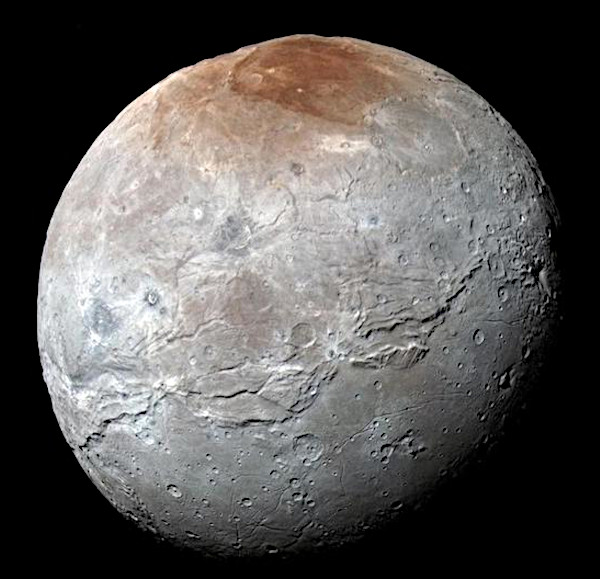
Description of the image: In 2015, NASA's New Horizons spacecraft captured Charon in high resolution. New Horizons was closest on July 14, 2015. The image combines blue, red, and infrared images taken by its MVIC (Multispectral Visual Imaging) camera. The colors are processed to better highlight the variation in Charon's surface properties. Charon's color palette is not as diverse as Pluto's. The most striking feature is the polar region, the red (at the top) unofficially called Mordor Macula. This image resolves details as small as 1.8 miles (2.9 kilometers). Image credit: NASA / JHUAPL / SwRI
Charon presents several amazing and unique features.
Charon has a diameter of about 1,212 kilometers, which is just over half the diameter of Pluto. It is one of the largest moons relative to the size of its planet in the Solar System.
Charon's mass is approximately 1.586×10^21 kilograms, which is about 12% of Pluto's mass.
Charon's surface is mainly composed of water ice, with traces of hydrated ammonia and possibly methane ice. This composition differs from Pluto's, which contains more volatile ices like nitrogen, methane, and carbon monoxide.
Charon's surface is characterized by deep canyons, mountains, plains, and craters. One of the most remarkable features is the canyon of Serenity Chasma, which is about 1,000 kilometers long and can reach depths of up to 9 kilometers.
Charon's north pole has a reddish region called Mordor Macula. This coloration is likely due to the presence of tholins, complex organic compounds formed by the irradiation of methane ice.
There are indications that Charon might have had cryovolcanic activity. Cryovolcanoes, or ice volcanoes, eject volatile substances such as water, ammonia, or methane, which quickly freeze in the cold space environment.
Charon shows signs of tectonic activity, with faults and rifts indicating that its crust has been fractured by internal forces. This could be the result of the contraction of its frozen underground ocean or the cooling and contraction of its interior.
Charon and Pluto are in synchronous rotation, meaning they always show the same face to each other. Charon's orbital period around Pluto is 6.387 Earth days, which also corresponds to Charon's rotation period.
Due to Charon's relatively large size compared to Pluto, the center of mass of the Pluto-Charon system (the barycenter) lies outside of Pluto. This makes it a unique binary system in the Solar System.
It is likely that Charon formed as a result of a giant impact between Pluto and another object from the Kuiper Belt. The debris from this collision would have accreted to form Charon.
Charon may have had an underground ocean of liquid water, maintained by heat generated from the decay of radioactive elements. Over time, this ocean would have frozen, contributing to the current geological features of the moon.
Unlike Pluto, Charon does not have a significant atmosphere. Any initial atmosphere would likely have been too weak to persist in Charon's extremely cold and low-gravity conditions.
In summary, Charon is a remarkable moon due to its large relative size, complex geology, and dynamic interactions with Pluto. Discoveries made by NASA's New Horizons spacecraft in 2015 have greatly enriched our understanding of this moon and its unique features.